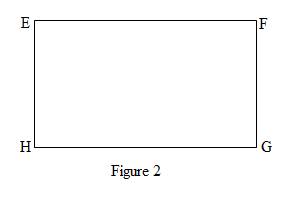
Students sometimes get confused about the relationship between squares and rectangles. Explain this relationship In your own words, using our (short) definitions of these shapes
To explain: The relationship between squares and rectangles.
Explanation of Solution
Consider a square shown in Figure 1.

The above Figure 1 represents square ABCD.
The sides of square AB, BC,CD, and DA are equal.
Consider a rectangle shown in Figure 2.

The above Figure 2 represents rectangle EFGH.
The sides of square EF, GH are length of the rectangle and are equal in size.
The sides of square EH, FG is breadth of the rectangle and is equal in size.
All angles of rectangle are right angle.
Therefore, it can be observed that the square has all side equals and every angle form right angle similar to rectangle.
Therefore, every rectangle can be square but every square cannot be rectangle.
Want to see more full solutions like this?
Chapter 10 Solutions
Mathematics for Elementary Teachers with Activities (5th Edition)
Additional Math Textbook Solutions
Finite Mathematics for Business, Economics, Life Sciences and Social Sciences
Pathways To Math Literacy (looseleaf)
Precalculus: A Unit Circle Approach (3rd Edition)
College Algebra (Collegiate Math)
Precalculus
Elementary Algebra For College Students (10th Edition)
- Please refer belowarrow_forwardMatlab Do question #3 from Section 1.10 Exercises of the textbook (theproblem about Mac and Cheese). For each part, be sure to explicitly give the appropriate system ofequations (as a comment) before entering the appropriate matrices into MATLAB. Show all of yournecessary MATLAB computations.arrow_forwardPLEASE ANSWER ALL PARTSarrow_forward
- PLEASE ANSWER BOTH PARTSarrow_forward(1) (16 points) Let f(x, y) = 2x + 3y + In(xy) (a) (6 points) Calculate the gradient field Vf(x, y) and determine all points (x, y) where ▼f(x, y) = (0, 0). (b) (4 points) Calculate the second derivative matrix D²f(x,y).arrow_forwardLet f(x, y) = 2x + 3y+ In(xy)arrow_forward
- (3) (16 points) Let D = [0, π/2] × [0, 7/6]. Define T: DCR2 R3 by → T(0, 4) = (2 sin cos 0, 2 sin sin 0, 2 cos x). Let S be the surface parametrized by T. (a) (8 points) Determine the normal, call it n(p), for the tangent plane TS at an arbitrary point p = T(0, 4). (b) (4 points) Show that n(p) parallel to the position vector T(0, 4) determined by p? Do the two vectors have the same direction or opposite direction? Explain. (c) (4 points) At which points p, if any, is TS parallel to the xy-plane?arrow_forward5:19 0 TEMU TEMU >>> 49 95% University at Albany - Single Sig... L Lumen OHM D2L HW4- AMAT100-Precal HW4 Score: 12.99/21 Answered: 18/21 × Question 16 Score on last try: 0 of 1 pts. See Details for more. > Next question Get a similar question You can retry this question below Find the inverse for the function k(x) = √√7x+12 k-¹(x) = Question Help: Video Message instructor Submit Question esc ||| F1 80 ୮ (x) = tarrow_forwarduse components when solvingarrow_forward
- File Edit View History Bookmarks Profiles Tab Window Window Help Things Quadratics! Part 1 X SM◄))) 61% Fri 25 student.desmos.com/activitybuilder/instance/67b739e7356cae7898fd0dbd/student/67b8f115811d42186c239e23#screenid=41a95 ngs Quadratics! Part 1: Parabolas Mitchell 30 30 foo feet 20- 20 10 0 -10 FEB 21 3 10 10 80 FS F3 X Intercepts #2 20 20 Approximately how tall is the shooter? > Which intercept did you use to solve the above problem? x-intercept y-intercept 30 feet Explain your thinking. 1 √E Submit 00000 acBook stv 399 ? DOD 000 F4 % 5 W E R F5 A F6 F7 F9 & * 7 8 9 0 Y U C 014arrow_forwardMatlab. Add written awnsers (denoted by stars) in comments.arrow_forwardmin(sin x, cos x) 2πT 0 max (esin x, ecos x dxarrow_forward
 Holt Mcdougal Larson Pre-algebra: Student Edition...AlgebraISBN:9780547587776Author:HOLT MCDOUGALPublisher:HOLT MCDOUGAL
Holt Mcdougal Larson Pre-algebra: Student Edition...AlgebraISBN:9780547587776Author:HOLT MCDOUGALPublisher:HOLT MCDOUGAL Trigonometry (MindTap Course List)TrigonometryISBN:9781337278461Author:Ron LarsonPublisher:Cengage Learning
Trigonometry (MindTap Course List)TrigonometryISBN:9781337278461Author:Ron LarsonPublisher:Cengage Learning
 Glencoe Algebra 1, Student Edition, 9780079039897...AlgebraISBN:9780079039897Author:CarterPublisher:McGraw Hill
Glencoe Algebra 1, Student Edition, 9780079039897...AlgebraISBN:9780079039897Author:CarterPublisher:McGraw Hill






